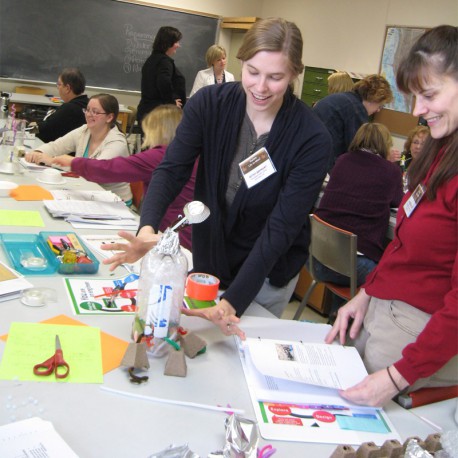 View larger
View larger
Build a Space Colony
New activity
Participants design technology to provide air to breathe, plentiful food, shielding from ultraviolet light, power, and more for space explorers.
Open Activity
How-to Video
Teacher's Guide
Provides classroom connections, key concepts, connections to science standards, and additional resources.
-
Rating
-
Participants Enjoyed the ActivityParticipants Learned from This ActivityActivity Instructions Were Clear and Easy to FollowWould Recommend
Related Programming Resources
Reviews
Building a space colony
My library did this program with mixed-age elementary school students during an outreach program at the local school's after school program. We pulled a book about the International Space Station and Buzz Aldrin's book, "Welcome to Mars," and in addition to the background content provided within this lesson, read some selective pages to give the kids some context and images to look at. I'm not sure the kids we worked with learned as much as we had intended with this lesson, but they had a tremendous amount of fun building their own habitats with the materials, redesigning when parts didn't work and connecting their various creations to form a larger colony. One kid installed booby traps for aliens, which took me by surprise, but it struck me as creative and pretty strategic to have security systems in place!
Inhabit Mars
This last weekend, I did a program called Inhabit Mars. I followed this outline and added in an element from UV Kid.
To start with, I asked the kids when they thought people would start living on Mars. After accepting various answers, I told them that NASA intended to have people living on Mars by 2030. That’s in 12 years! I asked them how old they would be in 12 years, then pointed out that any one of them could be colonists on Mars!
Then we discussed the types of things that people need to survive, and I wrote their answers on a white board. Next, we discussed the challenges that Mars presents to colonists. All these things are listed in the Build a Space Colony program, so you don’t need to have figured it out yourself ahead of time.
Then I had all the kids grab a partner. Ahead of time, I had prepared slips with the different components of a space colony, cut them up, and taped them to the back of our white board. I had the teams come forward and chose which components they were going to build, and set them loose on our building supplies.
Oops! Let me back up. I also made little pipe cleaner people ahead of time, each with 6 UV beads on them. If you haven’t seen these before, they are white, but turn colors when UV light hits them. I gave each team its own person and explained that these were colonists. Their colonist had to be able to fit into whatever they were making, and they had to protect their colonist from radiation. I showed them how the beads change color using a UV flashlight (these are easy to find—you can use pet urine detector flashlights). This took care of the “scale” part of the colony. The first thing every team did was build their colonist a space suit. Those kids were not going to let radiation damage their colonists!
The Build a Space Colony program has an extensive list of types of materials to collect, and we had all those in addition to whatever we had lying around. I had also collected a bajillion ½ gallon milk cartons. I had duct tape, electrical tape, and scotch tape on hand as well as scissors. I kept a box cutter in my back pocket, and I would poke a hole or make a cut in any material for anyone who asked. The noise level rose, the creative juices flowed all over the place, and kids were excited. One little girl kept exclaiming, “I LOVE this! I just LOVE this! I want to do this at home!” And she didn’t just say it that once—she said it to anyone who would listen.
The kids had about 45 minutes to work, and then I gathered everyone into a group and had each team explain their part of the colony. We used the UV light to see if the colonists were exposed to radiation (everyone passed!). Then we let the kids decide who would take the components home—because they all wanted to.
If I had more time in the program, I would have had the kids lay out the colony and discuss how they would deal with some of the dangers of Mars. But even without doing that, I would totally count this as a successful program.



